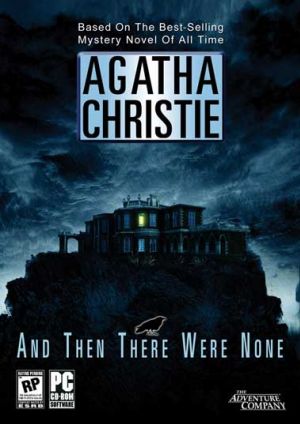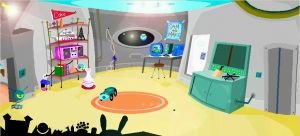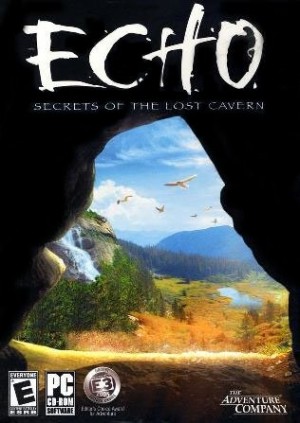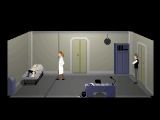Review for Professor Layton and the Diabolical Box

Game information
Adventure Gamers Awards
It may seem like an exaggeration, but when thinking of Professor Layton and the Diabolical Box, grandiose box-quote classifiers immediately come to mind. Things like “Best Adventure Game on DS” or “Best Puzzles in a Game” are right at the forefront of such superlatives. If you’ve played the wonderful Professor Layton and the Curious Village, however, you’ll know these aren’t just empty claims, and in the sequel you’ll find that, much like before, developer Level-5 has brought us a beautiful, polished, and challenging game.
But let’s say you’re new to the series, yet familiar with traditional adventure games. In that case, you may want to gently set aside the Layton series from the rest of the pack. They are essentially adventures in their own right, but this is a series where the puzzles are so prominent, so distinctly self-contained, and so clear and logical, the sense of immersion comes primarily from tackling each and every puzzle, outside of the story. There’s one of those as well, but these are games that shouldn’t even warrant a walkthrough, because they’re more of a personal test than standard adventure fare. It’s a confrontation between the puzzles and your mind, without the arbitrary point-and-guess element of many adventure games.
Oh, and another primer for those just joining in: cast all worries aside about the prospect of starting in on a sequel. Diabolical Box (or Pandora's Box as it's known in the UK) is more of a standalone episode, really; the only thing you’ll miss out on is a few nods to original cast members. As for our heroes, Professor Herschel Layton is an atypical archeologist/detective protagonist: a kind, gentlemanly sort with a proclivity for tea and puzzling. Like in Curious Village, Layton’s cutesy kid-detective chum Luke tags along, so expect many of the puzzles to derive from Layton and Luke puzzling one another.
Other than that, it’s a brand new storyline, this time concerning an ancient Elysian Box that supposedly kills those who open it. The Professor discovers it through his friend, Dr. Andrew Schrader, who sent a letter informing Layton that he now has the box (for research reasons, of course). He writes about the mystery surrounding it, feeling he’s on the cusp of something important. The letter also acts as a makeshift will, as he’s apparently going to open the box after sending the letter. With haste, Layton and his sidekick set out to Schrader’s address, anxious to find out if he’s even alive. As to be expected, mystery upon mystery unfolds after that.
Along with finding the coveted box, Layton stumbles upon a train ticket with no destination, which then leads him to a fancy and ornate train, which in turn takes him to a strange town to continue his investigation. Much more is unraveled, of course, and you’ll uncover new events and characters in a very linear fashion. Luckily, the stark linearity serves the experience well, giving the game a tight scope with the focus continually on its puzzles. If there’s any uncertainty about the plot details, it’s all well documented in the menu (Layton’s “trunk”) for you to peruse when the mood strikes. And with a brief recap every time you load a saved game, you’ll never, ever be confused, even if some time has passed since you played last.
For those who did play the original game (and I strongly recommend everyone does, even if it isn’t necessary), it’s all the same as before, more or less. Talk to characters, tap on a shoe to go from one area to the next, and expect a puzzle to pop up at any given moment. The difference is in the location. While Curious Village was mostly set in… well, a village, this time around you’ll visit several different villages, as well as trains, vast forests, and a huge castle, all making this game feel a little bit bigger. Not only that, the music is more varied to reflect the tone of your settings. The simple street musician accordion is still here, but there’s also dramatic strings and moody piano depending on your locale. Aside from the variety of environments, the look is very much the same: an odd yet lovable hybrid of European animation with a few elements borrowed from Japanese Anime.
The story plays out very much like it did in the first game, which is fine, but that once again means it lacks much depth as a result. You’ll meet dozens of characters in your travels, all of them quirky, yet slightly dull and simplistic. The same can even be said for Layton and Luke, which is really too bad. A sequel allows plenty of opportunity for some sort of character growth, but instead they remain merely singlemindedly inquisitive, cheery folk that are fixated on doing puzzles and solving things. And while there’s a travel brochure’s worth of Features! Locations! Extras! in this game, it almost feels like they are trying to distract you from the lack of a more cohesive story.
You see, the first Layton title had just as much charm, but there was an intangible extra: it had a little more heart, less cheese. It didn’t quite have the grace and personality of a Miyazaki film, but it was closer. Diabolical Box still has the charm, and tries to have heart, but something is lost in lieu of Trying Too Hard – seriously, this episode contains everything from sword fights to ghost towns to vampires, and its narrative seldom feels natural or engaging on its own (quite apart from the puzzles). Instead, it feels like a window-shopped sampling of characters and genres, with no real depth or focus to shape them all.
Having said that, it’s far and away the 150+ puzzles that are the highlight in this game: they’re varied, challenging, and rarely seem obvious – or even possible – from the get-go. Unlike many adventures, these are all pure logic puzzles. Some may intimidate you at first, like a puzzle involving shape radius or another that has you synchronizing a broken clock, but there’s no advanced Algebra class needed for this game; all you need is your wits. Same goes for a puzzle involving knots and a daunting, tangled mess of ropes. The puzzles here are all about thinking systematically. Even if you’re dealing with simple sliding puzzles or mazes, they’re only “simple” when you figure out the clever twist that makes the puzzle easy. And to make it all worthwhile, you’re amply rewarded for your efforts, unlocking bonuses by completing puzzles on the first or second try. Having trouble? There are always hint coins – a series staple – to collect and use when things get a little unsavory.
The feel of playing these puzzles on the DS is fantastic. They all use the touch screen, and most are done well; whether you’re writing in numbers with the stylus or simply selecting an object, it feels natural. The puzzle presentation is top-notch, too, and many of them have familiar pictures surrounding the puzzle (such as characters you’re interacting with) to tie in with the story. The singular song of chimes that plays while puzzling is reminiscent of Jeopardy in a way, yet soothing enough not to be a distraction.
There are only a select few caveats to this otherwise great puzzling experience. First, the puzzles begin to feel a little repetitive at times, as certain types have two or three versions of varying difficulty. Not so exciting, especially if a particular puzzle type isn’t your thing. Does the phrase “word problems” make you cringe? Then you’ll probably despise a good fifth of the puzzles offered here. A few other little complaints: one puzzle makes you draw a perfect circle. Drawing on the DS is awkward as it is, and it feels like too much to ask for those who aren’t artistically inclined in the first place. There’s also one puzzle with poor word choice (that’s you, Puzzle 47), and one with typos (puzzle 77, please step aside).
Adding a bit more variety, I really appreciated the fine selection of meta games in Professor Layton’s trunk, all which are unraveled gradually throughout the game. Curious Village had very basic minigames, be it a rudimentary jigsaw puzzle or casually arranging furniture. This time around, activities are similar but more quirky and complex. There’s another puzzle to piece together, for instance, but this time involving a complicated camera. There’s also a tea minigame that’ll test your creativity. Throughout the game you’ll discover new ingredients for tea, which you can then combine to make unique blends, which then can be used to cure certain ailments of characters along the way. These minigames are all very casual in nature, yet work as great pace-changers from the hardcore nature of the main puzzles, making for a pleasant sidestep from the primary adventure. But even if you’re looking for more traditional brain teasers, there are bonus puzzles of that type available as well, plus (for a limited time) you can find still more downloadable puzzles each week at the Professor Layton website.
If I had a complaint about gameplay in the first Layton title, it’d mostly be the puzzles not really gelling with the more important moments in the story. You’d find puzzles by merely bumping into characters, not by delving into actual mysteries. That’s still a feeling you’ll get quite often this time around, possibly to your chagrin. Any topic raised, whether it’s diner food or family fortune, will prompt an immediate appetite for puzzling from anyone involved. And while the first game ultimately had a reason for all this crazed puzzling, this game does not. And frankly, it feels a little cheap at times.
But when it really matters, right when you’re getting to the heart of a mystery, you can rest assured that there will be a logical puzzle for the situation you’re in. You’ll fuddle with keys to open a door, tinker with lights to illuminate a forest, or piece together a much-needed map, and shortly you’ll find your way to the next location. Solving these better-integrated puzzlish acts really moves along the story bits with a slideshow of drama. But, like in Curious Village, there will still be those moments where you’ll say to yourself, “Oh. Great. I’m stacking pancakes. Why am I doing this?”
Without tampering with a successful formula, any new Professor Layton adventure was bound to be welcome, but this one is all the more so for its many little extras and intriguing locales. The story does feel a little flatter than its predecessor’s at times, but don’t be surprised not to notice very often, since you’ll be too wrapped up in the sequel’s equally amazing, if hair-ripping puzzles. And you’ll stay wrapped up for a fair while, too, as the game could run anywhere from 15 to maybe 30 hours, depending on your play style. I expect many will either play Professor Layton and the Diabolical Box like I did – in a frenzied, relentless hunt for more puzzles – or in a slower-paced, exploratory way: trying all the tea varieties, speaking to all the townsfolk, and taking things one puzzle at a time. Either way, for puzzle fans it’s a brilliant way to spend your time, and so long as you’re playing, that’s really all that matters.






















__small.jpg)





